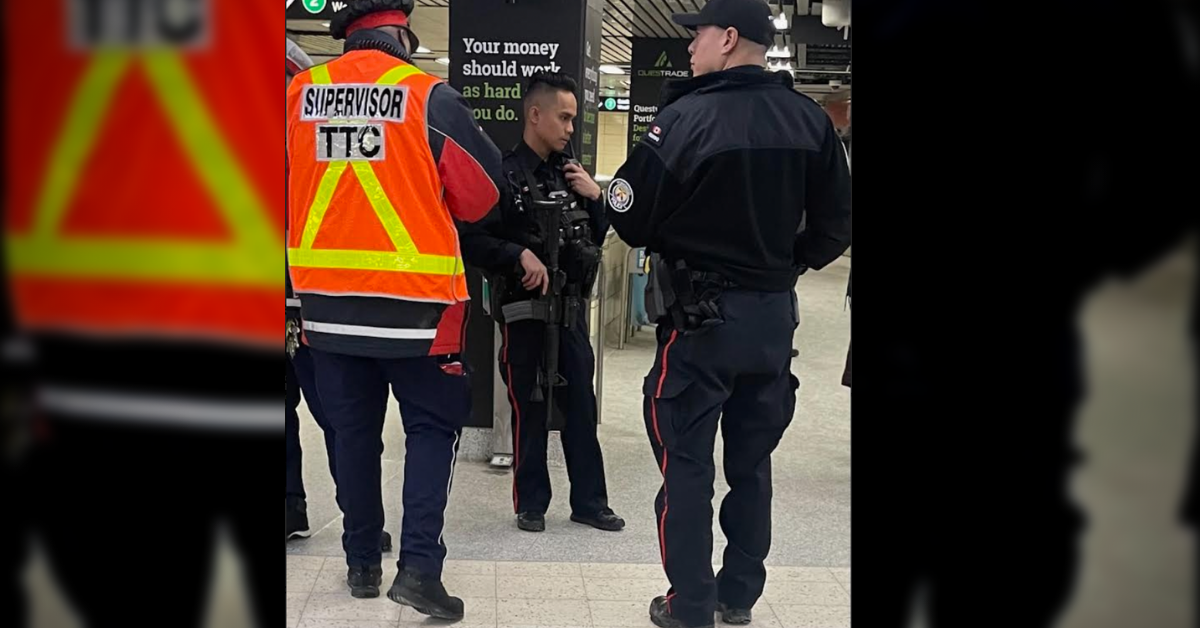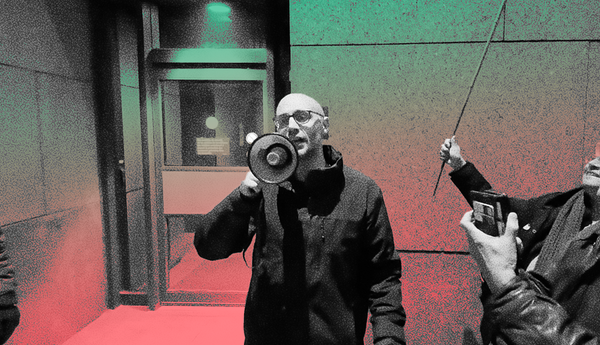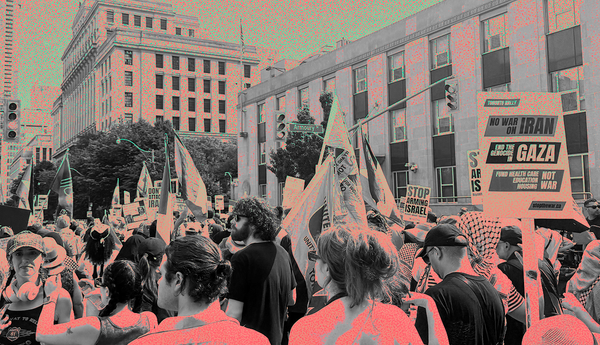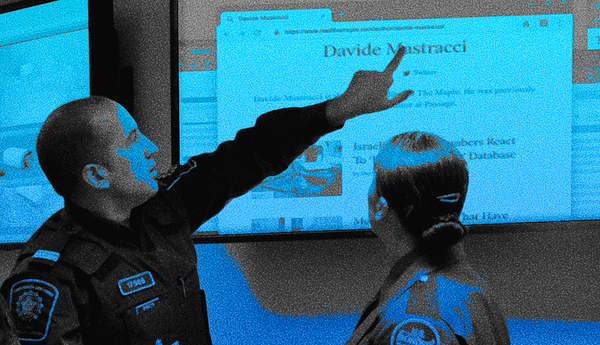A widely shared photo of a police officer holding an assault rifle in the Toronto subway was not part of a recently announced security surge, but appears to demonstrate a pre-existing trend in militarized responses to incidents on Toronto’s public transit system, sources suggest.
On January 26, former Toronto mayor John Tory announced a significant increase in the Toronto Police Service’s (TPS) presence on the Toronto Transit Commission (TTC).
The police surge was in response to a perceived increase in violent attacks on the TTC over the course of the past year. Just two days before Tory’s announcement, a woman was nearly stabbed to death on a downtown Toronto streetcar.
Toronto Police Chief Myron Demkiw announced that more than 80 Toronto police officers would be deployed throughout the TTC, effective immediately.
The same day, the Twitter account of the Toronto Police Mounted Unit released a photo of a mounted officer outside the TTC’s St. Clair subway station. The photo was widely ridiculed, given the impracticality of mounted police in a subway system.
As well, the absence of snow on the ground confirmed that the photo had in fact been taken some time before Tory’s announcement.
Responding to a question about the photo, the Twitter account of the Toronto Police Association indicated that it was taken on January 23 and that the police —including mounted units — had increased their “directed patrols” of the TTC for several weeks prior to Tory’s announcement.
That same day, the photo of the officer with the assault weapon began circulating on social media. It was taken at approximately 6:30 p.m. Eastern Time at the Bloor-Yonge subway station by Hannah Kern, an early childhood educator who lives in Toronto’s Annex neighbourhood.
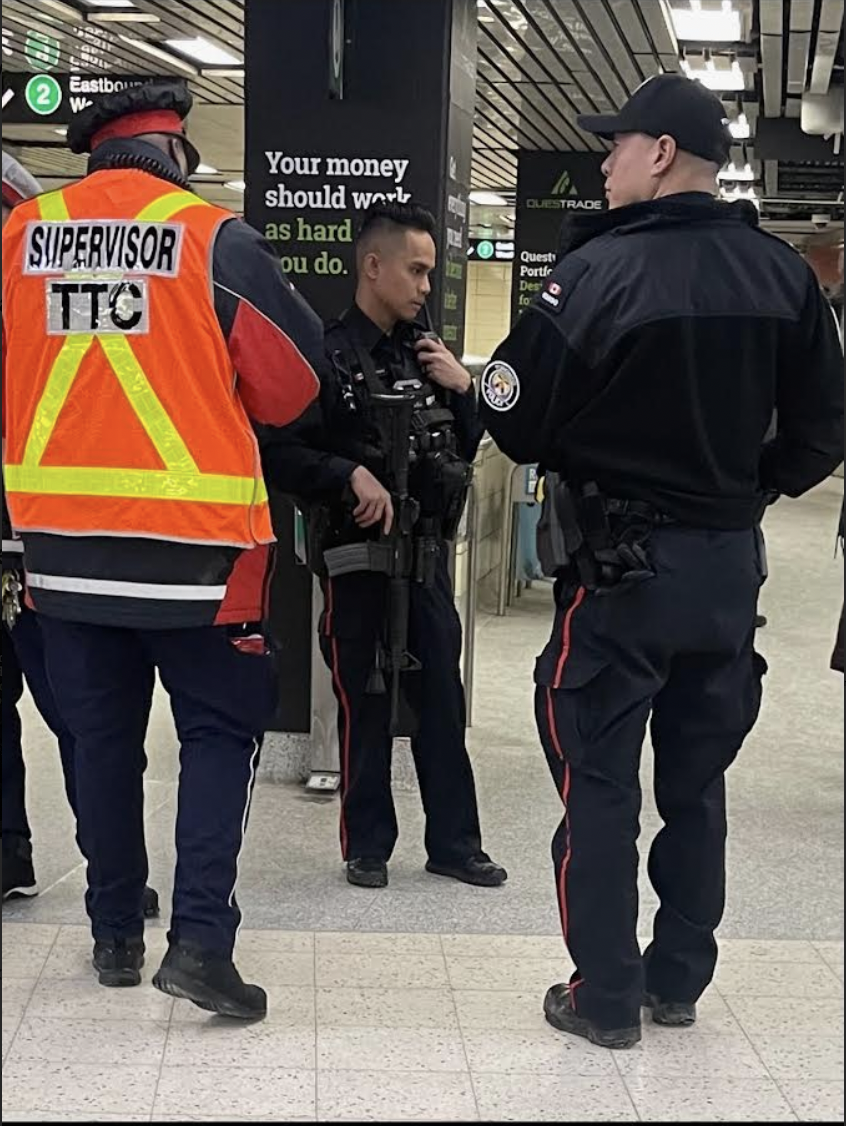
Kern entered the station and found stopped trains with their doors open and filled with passengers. She told The Maple that most passengers were still on board and that an announcement indicated service had been interrupted between St. Clair and College stations on the subway’s Yonge-University line.
Kern boarded the train and waited with the other passengers for a moment when she saw three uniformed Toronto police officers scanning the train. Kern recollects that at least two of the officers were holding assault rifles, including the one seen in the photo, and that they appeared to be looking for someone.
At one point, Kern recalled, one of the officers briefly boarded the train and was then called back by the officer in the photo, who told her to conduct the inspection from outside the train.
Despite an announced security incident that apparently required the intervention of several police officers equipped with assault rifles, Kern said that at no point was she, or any other passengers, told to leave the station, nor were others prevented from entering the station. The police did not try to evacuate the station, and there was no communication from the TTC indicating that the station should be evacuated.
“My first thought was whether I should be leaving, because I didn’t see anyone causing trouble on the trains … it seemed like most of the passengers were as confused as I was,” said Kern. “Suddenly these cops with assault rifles appear, and they were clearly very prepared to shoot them at any moment. I was disturbed by that and I left.”
The Toronto police later confirmed in a statement to The Maple that the weapon was a C8 rifle, which is the Canadian military designation for the carbine version of a C7 assault rifle, the standard infantry weapon of the Canadian Armed Forces.
The Maple provided the photo to the Toronto police and the TTC, indicating the time and location it was taken. Despite this, neither the TTC nor TPS would confirm the veracity of the photo, stating several times that they were “unable to confirm the details of when and where this photo was taken.”
However, in the same email, Constable Alex Li confirmed that the officer pictured was indeed carrying a C8 assault rifle.
The C8 can fire in full or semi-automatic mode, carries a 30 round magazine, has a practical rate of fire of 40 to 100 rounds per minute, and an effective range of about 300 metres.
In the photo, the weapon is pointed towards the floor. The officer’s right hand is resting on the handle with his finger pointed toward, though not on, the trigger, while his left hand appears to be manipulating his radio.
Kern said she observed an officer pointing their assault rifle upwards towards the ceiling at least once (TPS said weapons are held in this way for safety). Two other figures appear in the photo, including another Toronto police officer, and a TTC inspector supervisor.
A second photo appears to show the same two police officers as those in the first photo, accompanied by what appears to be a different TTC inspector, as well as several transit users.
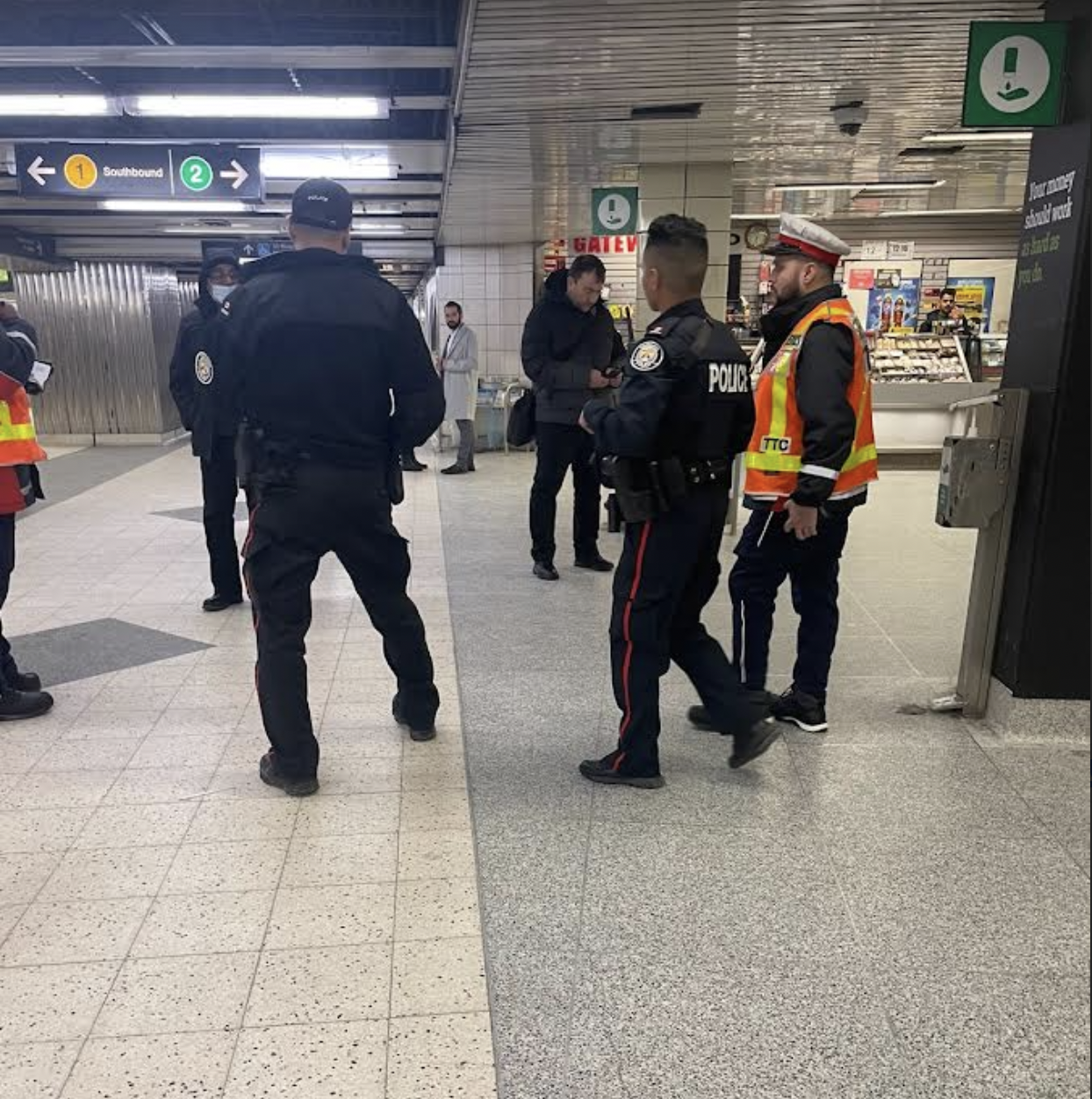
In neither photo does it appear that the police officers or transit inspector are in the process of clearing the station, nor communicating with the passengers. A Tweet issued by TTC Service Alerts at 6:20 pm that day indicated only that there was no service between St. George and Broadview stations on the Bloor-Danforth line.
As Kern made her way out of the station, she saw several other police officers standing around, some of whom were talking with TTC employees, but none of them trying to evacuate the station nor communicating with passengers to inform them of what was going on.
As Kern exited the station, she observed more police officers — perhaps as many as a dozen — and several cruisers with flashing lights. She witnessed no attempt by police to warn people away from the station or to inform the public of what was happening inside the station.
The Maple attempted to confirm Kern’s account with both the TTC and TPS.
The TTC’s senior communications specialist, Stuart Green, requested details from The Maple about who took the photo and when, but would not answer other questions, including about the nature of the incident, why TTC inspectors were on the scene and why passengers were not cleared from the station.
The Maple provided the date, time and location of the image, but Green deferred all further questions to TPS, which also did not provide answers.
TPS media relations officer Cindy Chung stated that neither she, nor TTC communications, could confirm the veracity of the photos obtained by The Maple.
Chung indicated that the police had contacted TTC about the photo, but provided no further details. Regarding the use of assault rifles on the subway, Chung stated:
“…Officers would not be carrying this particular firearm during regular patrols, on the TTC or anywhere else. This would likely have been in response to a priority call involving a serious public safety issue. Officers are well trained on when and how to use all use-of-force options at their disposal.”
Kern told The Maple that she later heard from a friend that a call had been made to TPS about someone with a gun on the subway. The police did not provide details regarding the nature of the incident.
However, earlier in the day on January 26, a group of teenagers were arrested for shooting a BB gun at a passenger at York University station. In that case, the BB gun was described as a replica firearm.
“Learning that there had been a gun concern onboard a train, my first thought was ‘what perfectly terrible timing,’ because this was the day of Tory’s announcement about increased policing on the TTC,” said Kern, who further explained her concern that the incident would be used to justify Tory’s public transit police surge.
When Tory made the announcement, he stated that the safety and security of TTC passengers and employees were his top priority.
Neither the TPS nor TTC would discuss the particulars of the incident, but confirmed that 911 calls were made to police on the date in question in reference to a suspected person with a gun at the Bloor-Yonge subway station.
The Maple reached out to the mayor’s office for comment, pointing out that the lack of communication from both the TTC and TPS on the nature of the incident, as well as the unannounced and unexplained presence of armed police officers, made passengers feel unsafe.
Taylor Deasley, press secretary and issues manager for the Office of the Mayor, replied that the mayor’s office does not direct the Toronto police on operational decisions, and further stated that “since John Tory’s resignation, the Mayor’s office would no longer speak on his behalf.”
Deasley forwarded The Maple’s questions back to the TPS and TTC. Stuart Green, speaking on behalf of the TTC, said that the TTC does not “direct or manage (the TPS’) response to public safety incidents,” despite the presence of uniformed TTC staff at the scene.
Neither the police nor the TTC responded to multiple requests for an explanation as to why the police did not identify themselves to passengers, why the station wasn’t evacuated of its passengers, nor why passengers weren’t prevented from entering the station, despite the apparent threat of a gunman on a train.
Kern doubts that the police presence on the subway improved her safety or security: “Regardless of whether a police officer has a gun in their hand or not, it’s always within their metaphorical reach, and increasing more police into the TTC will introduce harm.”
John Di Nino, national president of the Amalgamated Transit Union (ATU) in Canada — the union representing TTC employees — told CBC last month that increasing police isn’t going to help when services are being slashed.
The TTC, like metro transit providers across Canada, is dealing with a considerable budget deficit as a result of the COVID pandemic’s ongoing effect on mass transit usage.
TTC is also increasingly taking on a role as a de facto shelter for unhoused people. The increased police presence may discourage some passengers from returning.
While the TTC struggles with a $366 million budget shortfall, TPS received a $48 million budget increase from Tory, during a raucous budget meeting in which protesters were dragged out of Toronto City Hall.
While Kern had been concerned that the January 26 security incident would be used to justify increased policing, she’s also concerned about the existing prevalence of violence in the city. She believes this is typified by a police response to a security concern that included multiple assault rifles but no attempt to get passengers out of harm’s way.
“A gun call to the TTC — which ultimately didn’t amount to anything — this is one of the rarest forms of interpersonal violence … while everyday violence continues to happen to people experiencing homelessness, people experiencing mental health crises, and other highly marginalized and targeted populations, all of whom experience violence at the hands of the police, other passengers, society in general— and that’s what deserves far more attention,” said Kern.
Taylor C. Noakes is an independent journalist and public historian from Montreal.
Go deeper
Here are a few stories from our archive that expand on today's story
Black and Indigenous People Twice as Likely to Distrust Police
Data published by Statistics Canada shows Black and Indigenous people are twice as likely as others to report having little or no confidence in police.
Critics Highlight Police Double Standards in Ottawa
Critics noted that police took a far more heavy-handed approach against protests led by Indigenous people or those acting in defence of unhoused people than against the Freedom Convoy.
Top Maple story this week
Canada Noted Concerns Over Italian Far-Right Victory, But Was Reassured By Pledges To Maintain Geopolitical Status Quo

Newly obtained documents show the Trudeau government monitored concerns and far-right celebrations over Italy's election results last fall, but was seemingly reassured by the new Italian prime minister’s promises to maintain the status quo on European and transatlantic partnerships.
Catch up on our latest stories
- Canadian Officials Acknowledged Israel’s Forced Closure of Palestinian Infrastructure Violated Rights.
- Podcast: The Pierre Poilievre Problem.
- From The Readers: Real-Estate Investors Fuel Housing Crisis.


